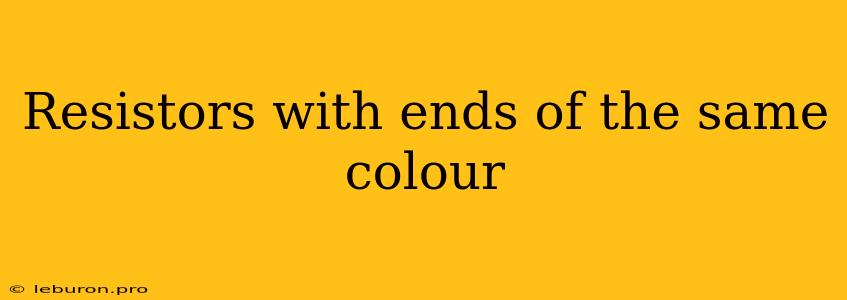Resistors are fundamental electronic components that play a crucial role in controlling and limiting the flow of electrical current within circuits. They achieve this by opposing the flow of current, effectively converting electrical energy into heat. A defining characteristic of resistors is their resistance value, which is measured in ohms (Ω). To facilitate easy identification and selection, resistors are typically marked with color bands that indicate their resistance value, tolerance, and sometimes even their temperature coefficient. One interesting aspect of resistor color coding is the occasional occurrence of resistors with ends of the same color. While this might seem unusual, it's not a defect or an error but rather a specific characteristic that can be helpful in certain applications. This article will delve into the nuances of resistor color coding, explore why resistors might have ends of the same color, and shed light on the reasons behind this seemingly peculiar characteristic.
Understanding Resistor Color Coding
The color coding system for resistors is a standardized method used to visually represent the resistance value, tolerance, and sometimes other parameters of a resistor. The most common system uses four to five colored bands on the resistor's body. Each band represents a specific numerical value or characteristic, and the combination of these bands determines the resistor's properties.
The Color Bands and their Values
The first three bands on a resistor represent the significant digits of the resistance value. Each band corresponds to a specific number, as outlined in the following table:
| Color | Digit |
|---|---|
| Black | 0 |
| Brown | 1 |
| Red | 2 |
| Orange | 3 |
| Yellow | 4 |
| Green | 5 |
| Blue | 6 |
| Violet | 7 |
| Grey | 8 |
| White | 9 |
For example, a resistor with the color bands Brown, Black, Red would have a resistance value of 1000 ohms (10 x 10<sup>2</sup> ohms).
The Fourth Band: Tolerance
The fourth band represents the tolerance, which indicates the permissible deviation from the nominal resistance value. The common tolerance values are:
| Color | Tolerance |
|---|---|
| Gold | 5% |
| Silver | 10% |
| No Color | 20% |
For instance, a resistor with Brown, Black, Red, Gold bands would have a resistance value of 1000 ohms with a tolerance of 5%. This means the actual resistance value can vary between 950 ohms and 1050 ohms.
Fifth Band: Temperature Coefficient
Sometimes, a fifth band is present on a resistor, indicating the temperature coefficient. The temperature coefficient represents the change in resistance per degree Celsius. While this band is less common, its presence provides additional information about the resistor's behavior under varying temperatures.
Why Do Some Resistors Have Ends of the Same Color?
Resistors with ends of the same color are not uncommon and are usually related to their intended application or manufacturing process. There are several reasons why this happens:
- Matching: In some circuits, it is crucial that resistors have identical or closely matched resistance values. This is especially true for applications like audio amplifiers, where slight variations in resistor values can lead to distortions and unwanted noise. Resistors with ends of the same color are often paired together to ensure a closely matched resistance.
- Manufacturing Processes: The manufacturing process for resistors can sometimes lead to instances where the ends of the resistor end up with the same color. This is often a result of the specific material used or the way the resistor is formed during production. While this doesn't affect the functionality of the resistor, it can be a visual indication of a specific manufacturing process.
- Resistor Size and Value: The size of a resistor can also influence the color of its ends. Larger resistors often use a different color for their ends compared to smaller ones. This is because the color of the end caps can be determined by the material used or the manufacturing process, which might be specific to certain resistor sizes.
Does it Affect Functionality?
The color of the ends of a resistor generally doesn't affect its functionality or electrical characteristics. The resistance value, tolerance, and temperature coefficient are determined by the color bands on the body of the resistor. The end colors are primarily used for identification and are not directly related to the resistor's electrical properties.
Examples of Resistors with Ends of the Same Color
You can often find resistors with ends of the same color in applications where:
- Precision is Crucial: High-precision circuits, like those found in audio amplifiers or measurement devices, frequently use resistors with matched values. Matching the resistance values is essential for achieving accurate and undistorted results.
- Resistor Networks: Sometimes, resistors are arranged in networks to achieve specific resistance values or other electrical properties. In such cases, resistors with ends of the same color might be used to identify the individual resistors within the network.
- Visual Grouping: When resistors are used in large quantities, their ends might be color-coded to visually group them based on their value or application. This can make it easier for technicians or engineers to identify the different types of resistors in a circuit.
Conclusion
The occurrence of resistors with ends of the same color is not an error or a defect. It's often a consequence of manufacturing processes, intended matching, or visual grouping strategies. While the color of the ends doesn't impact the electrical properties of the resistor, it can be a helpful visual cue for identification or grouping purposes. Understanding the reasons behind the color of the ends can be beneficial when analyzing circuits or selecting resistors for specific applications, particularly when precision or identification is crucial.
